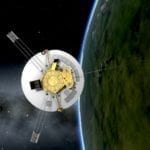In September, the Canadian Federal Government announced that it was investing a whopping $900 million in exceptional university research initiatives through the Canada First Research Excellence Fund (CFREF) competition. Among the 13 successful submissions was Queen’s University’s, whose proposal to build the Canada Particle Astrophysics Research Centre, or CPARC for short, received a big chunk of the pie: $63.7 million in funding. Not only is this terrific news for the advancement of science in Canada as a whole, the CPARC money is poised to place Canada at the global forefront of particle astrophysics.
So what exactly is particle astrophysics and why should we care about it? The official definition is that particle astrophysics is the study of the tiniest building blocks of nature and how they influence the structure and future of our universe. You would be an astrophysicist if you studied (whether through experiments or developing theories) one or all of the following:
- How our universe was born (insert buzzwords like “big bang” and “rapid expansion” here);
- How our universe works (believe it or not, we still understand very little about it);
- What planets, stars, galaxies, and clusters of galaxies are made of when they are parsed down to their smallest puzzle pieces;
- What will happen to our universe in the future (again, we know very little about this).
Right now, these questions are considered worldwide to be some of the most important in physics, and groups like CPARC are working on ways to tackle them.
CPARC’s successful funding proposal outlines plans to build a centre for particle astrophysics research, the first of its kind in Canada. It will be headquartered at Queen’s University but will include people and resources all over Canada and even globally. Specifically, CPARC’s goals are to:
- Build a big team of people working on all areas of particle astrophysics. In the past, SNOLAB has focused on some areas of the field, and CPARC research will include the experiments currently underway at SNOLABas well as other areas such as astroparticle theory, observational astrophysics, cosmology, and the development of new technologies that will improve scientific experiments as well as include industry in what happens at CPARC;
- Get the most out of the current SNOLAB experiments by ramping up resources;
- Go big and go global by forming international collaborations and building the next generation of particle astrophysics experiments; and
- Invest in education and outreach.
There are many interesting goals on this list, but I would like to focus on three that particularly stand out to me.
First, it is great to see that SNOLAB, a physics research lab located 2 km underground in Sudbury, Ontario, will play an integral role for CPARC. As we all know, SNOLAB has already produced a lot of award-winning science (for example, the 2015 Nobel Prize in Physics and the 2016 Breakthrough Prize in Physics were co-rewarded and rewarded, respectively, to the SNO collaboration for the discovery that tiny particles called neutrinos have mass, something that took decades of research and huge teams of people to say with certainty).
The second exciting goal of this research centre is that in addition to leveraging SNOLAB and its resources, CPARC will also hire many new scientists from more fields than SNOLAB currently encompasses. Logistically this will mean hiring top talent from Canada and abroad. News of new positions for scientists is always good to hear and in this case, bringing together the top research talent from our country and abroad will mean that CPARC can benefit from new perspectives and fresh ideas. These new hires will come from many fields including particle astrophysics theory (as opposed to experimental), cosmology, and observational astrophysics. Bringing these fields together will mean attacking important questions from many angles and with many perspectives in a more powerful way than was possible in Canada before.
The third goal that stands out might be the most exciting to those of us communicating science: CPARC has a comprehensive program for outreach and education. I had the opportunity to chat with Dr. Tony Noble, Interim Director of CPARC, about this program and he said that “involving students in research early on in their career, as early as their first year of university, helps everybody. It gets them excited right away, makes them feel included and important, trains them to be good scientists early on, and brings fresh ideas to any research team”. CPARC would involve young scientists through, for example, internship opportunities and summer schools.
In terms of public outreach, CPARC has ideas such as throwing public gala nights in Kingston with a physicist guest speaker, creating science exhibits about CPARC at Queen’s University, and partnering with other research centres to leverage and enhance existing programs in Canada.
The people of CPARC have a lot of exciting work ahead of them! To learn more or to keep up with CPARC news, check out the Queen’s University Gazette.




